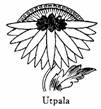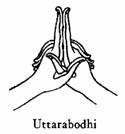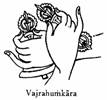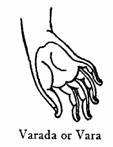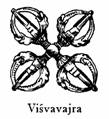|
Tantra
(Sk) |
"An
unbroken stream, flowing from ignorance to
enlightenment
." Tantra is the Buddha
's secret teachings and practises.
It is also a reference to the literature that expounds these doctrines.
Although originally Hindu
, the much changed Buddhist tantras
follow the course of symbolising, in painting and sculpture, the basic
duality of manifestation in the figures portrayed. In Buddhist
tantric
ritual sexual imagery is used to
explain the sacred union of wisdom and compassion
. The tantras also explain the many
aspects of ritual, such as where, and how to play music, arrange the
offerings on a shrine, and how to use the Damaru
and the Phurba
, and much, much more. |
|
|
|
|
Tara
(Sk) |
"She
Who Liberates". |
|
|
|
|
Tarjani-mudra
(Sk) |
"Threatening". Except for the index finger, all fingers and thumb
are folded into a fist. |
|
|
|
|
|
|
|
Tarpana
(Sk) |
Gesture of homage. |
|
|
|
|
|
|
|
Teapot |
Decorative brass, copper
or bronze
teapots were used in ritual
ceremonies in which buttered-tea is brewed. Some of these objects are
works of art. Read the Arts of Tibet
section. (See Photo 13.) |
|
|
|
|
Terracotta |
See
Amulets
and read the Arts of Tibet
section. |
|
|
|
|
Thokde
(T) |
"Sky-stone". Magical stones and objects regarded by the Tibetans as
very powerful prophylactics against evil. These objects were found in
fields and in and around river-beds. The objects show strong
archaeological links with the pre-historic world of |
|
|
|
|
Thangka
(T) |
|
|
|
|
|
Thighbone
Trumpet |
A
trumpet made from the thighbone (femur) or a man and sometimes covered in
yak or even human skin. It is said by visitors to |
|
|
|
|
Thunderbolt |
See
Vajra
. |
|
|
|
|
Trident |
See
Trisula
. |
|
|
|
|
Trikona
(Sk) |
"Triangle". All figures in Dhyanasana
form a triangle. |
|
|
|
|
|
|
|
Tri-murti (Sk) |
"Triad". One figure containing the three
aspects of Avalokitesvara , Manjusri and Vajrapani . |
|
|
|
|
Tri-ratna
(Sk) |
"Three Jewels". The three symbolic jewels are the
Buddha
, Buddhist law and Buddhist
community. See Trikona
. |
|
|
|
|
|
|
|
Trisula
(Sk) |
"Three Points". A three-pronged fork. A Buddhist and a
Hindu
symbol.
|
|
|
|
|
|
|
|
Tsong-Khapa
(T) |
"The
Man from the |
|
|
|
|
Tshog-shing
(T) |
A
Thangka with Tsong-khapa as its central deity. (See Photo 22.) |
|
|
|
|
Tulku
(T) |
"Emanational Body of a Buddha
". The appearance on earth of the
body of a Buddha who has refused to accept Nirvana
, and who has arrived to assist
mankind in his search for inner peace and realisation. The Tulku is a
reincarnation, not necessarily a powerful one, but nevertheless an
outstanding contributor to man's eternal search. The Dalai Lama
and the Panchen Lama are also
manifestations of this doctrine. |
|
|
|
|
Utpala
(Sk) |
Blue
Lotus
. A symbol. |
|
|
|
|
|
|
|
Urna
(Sk) |
"The
Third Eye". The flaming pearl (Cintamani
) in the centre of the forehead,
between the eyes, symbolises unity, harmony, transcendent wisdom,
spiritual insight, crystallising light and deliverance from duality. |
|
|
|
|
Usnisa
(Sk)
|
The
protuberance on the skull of the Buddha
image. Some sources state that this
is the area of the Buddha's highly advanced intellectual faculties, others
say that the Usnisa represents the flame of Nirvana
. |
|
|
|
|
Usnisavijaya
(Sk) |
A
feminine bodhissatva. (See Photo 31.) |
|
|
|
|
Uttarabodhi
(Sk) |
See
Ksepana. |
|
|
|
|
|
|
|
Vahana
(Sk) |
A
support. Supports for the many deities
come in many shapes and sizes too
numerous to include here. However, here are some of the more popular
examples: lotus throne, lion throne, demons
, corpses, garudas, nagas, peacocks,
bulls, a live male or female mortal, elephants, birds, dragons, horses,
pigs and cushions. |
|
|
|
|
Vairocana
(Sk) |
"Radiant Light". One of the five Dhyani Buddhas. He sits in
Dhyanasana
on a lotus base. His hands are in
Dharmacakra-mudra or Dhyani-mudra and when in the former mudra, he holds a
cakra. |
|
|
|
|
Vajra
(Sk)
|
Dorje
(T) Originally the thunderbolt of
the Indian god Indra, with which he dispersed the clouds of ignorance, the
vajra became the symbol of the "method" in the tantric
form of Buddhism
which was introduced into
|
|
|
|
|
|
|
|
Vajradhara (Sk) |
"Holder of the Thunderbolt ". The Adi- Buddha . Has several popular
forms. He sits in Dhyanasana on a lotus base, his hands are in
Vajrahumkara-mudra , holding a ghanta
and a vajra. Another popular in is Yab-yum with his Sakti . |
|
|
|
|
|
|
|
Vajrahumkara-mudra
(Sk)
|
"Eternal Buddha
". A posture. Hands are crossed at
the chest level, usually holding a ghanta and a vajra. Symbols of
Vajradhara
. |
|
|
|
|
Vajrapani
(Sk) |
"Bearer of the Thunderbolt
". One of the five
Dhyanibodhissatvas
. This deity has many forms - too
numerous to include here. The following is one of the most popular
examples: Vajrapani steps to the right, holds a vajra in his uplifted
right hand, his left hand is in vitarka-mudra. The tantric forms have multiple heads, arms and
legs and are often in yab-yum with their Sakti
. (See Photo 47.) |
|
|
|
|
Vajrasana
(Sk) |
"Thunderbolt
Throne". See Dhyanasana
. |
|
|
|
|
Vajrasattva
(Sk) |
"Essence of the Thunderbolt
". The Adi-Buddha
. He sits in dhyanasana or
lalitasana. His right hand at chest level holding a vajra, his left hand
in dhyani-mudra and holds a ghanta. There is a standing form in which he
balances a vajra on his open right palm at chest level, while his left
hand holds a ghanta against his thigh. (See Photos 29-30.) |
|
|
|
|
Vajrayana
(Sk) |
A
tantric
|
|
|
|
|
Vajrayogini (Sk) |
A
dakini who among her other duties guards the dead. |
|
|
|
|
Vajrakilaya
(Sk) |
A
meditational deity. See Phurba
. |
|
|
|
|
Vara-mudra
(Sk) |
Same
as Varada-mudra
. |
|
|
|
|
Varada-mudra
(Sk) |
The
posture of giving charity. Arms down, palm outwards, fingers all extended
downward. Classic mudra of the Medicine Buddha
, White Tara
and Green Tara. |
|
|
|
|
|
|
|
Vasudhara
(Sk) |
"Plenty". One of the feminine Bodhissatva
, much loved and worshipped in
|
|
|
|
|
Vina
(Sk) |
A
lute. |
|
|
|
|
|
|
|
Visvapani
(Sk) |
"Double Thunderbolt
Bearer". One of the five Dhyani
Bodhissatvas
. Standing or sitting, he holds a
cruciform double vajra. |
|
|
|
|
Visvavajra
(Sk) |
"Double Thunderbolt
". Fixed together in the middle this
cruciform shape resembles the letter X. |
|
|
|
|
|
|
|
Vitarka-mudra
(Sk) |
"Argument Posture". The arm is bent and all the fingers extend
upwards, except the index finger, or the ring finger which touches the tip
of the thumb. Mudra of Maitreya and others. |
|
|
|
|
|
|
|
Votive
plaques |
These objects are used as offerings to Buddha
and the many other deities
. Kept on the family altar or inside
amulet boxes worn around the neck. They are usually sold by itinerant
Lamas to pilgrims or villagers. Rarely larger than five or six centimetres
in height, one side contains a pressed or carved figure of a deity, while
the reverse side is often engraved with the deity's name and even
sometimes, the date. They are made of clay
, stone, bronze
, copper
, iron, silver and gold. See
Amulets
. |
|
|
|
|
Weapons |
For
use against evil forces or spirits. See Capa, Khadga,
Phurba
and Sara, etc. |
|
|
|
|
Wheel of
Life |
See
Wheel of Life section. |
|
|
|
|
Wheel |
Cakra
. See Vairocana
. |
|
|
|
|
|
|
|
Yab-yum
(T) |
"Father, Mother". The sexual union of a male deity with his female
energy (Sakti
). This sexual symbolism
, originating from the Hindu
pantheon, is not a form of erotica
to the Tibetan
Buddhists. The female aspect, in
the posture of explicit sexual union, provides her consort with spiritual
wisdom. He provides her with spiritual compassion
. Together their power is whole and
complete. See Tantra
. (See Photo 48.) |
|
|
|
|
Yama
(Sk) |
"Lord of Death". One of the Dharmapala
. He is always standing and clad in
garments of fire. His aspect is very fierce. A human face with a fanged
rictal-grimace or a bull's head. He stands on a bull or a naked woman, or
both. He can have multiple arms and legs and holds a variety of Buddhist
symbols, such as the cakra, kapala, karttrka, skeleton-topped pole and a
pasa. (See Photos 55-56.) |
|
|
|
|
Yamantaka
(Sk) |
Gshinrje (T) "Defeater of Death". One of the
Dharmapala
. An example of the powerful forces
of cause and effect. Terrifying and monstrous, he always stands on
demons
, animals, birds, elephants and
humans. (Usually symbolic of Hindu
deities.
) Yamantaka can have one or nine
heads, two arms or hundreds! The same applies to the number of legs. He
wears a hideous grin on his slavering bull's head, and two frontal horns
curl wickedly upward from his temple
. With or without a Sakti
this is the stuff of nightmares.
His symbols are Kapala
, Karrtrka, Damaru
, Khadga and flayed cloak of human
skin, replete with scalp. (See Photos 55-56.) |
|
| |
|
See
Mandala
. | |
|
|
|
|
Yellow
Hats |
See
Gelugpas
. |
|
|
|
|
A
missing-link type creature that is supposed to roam | |
|
|
|
|
Yi-Dam
(T) |
"Protective Gods". In |
|
|
|
|
Yonzdzin
(T) |
A
teacher of philosophy
to a high ranking Lama
or a Dalai Lama. |
|
|
|
|
Zhangzhung
(T) |
The
birthplace of Bon
. Located somewhere in
|





